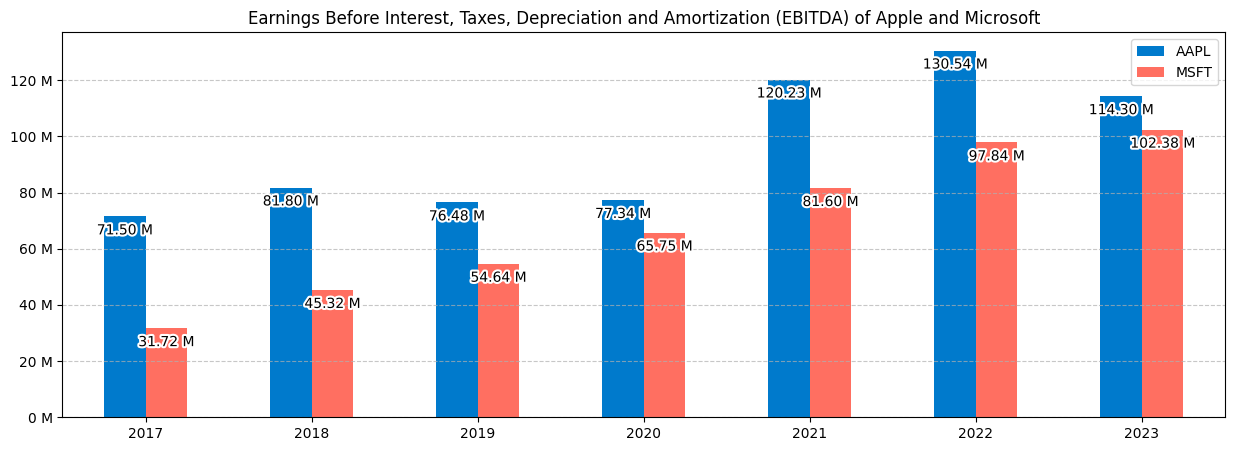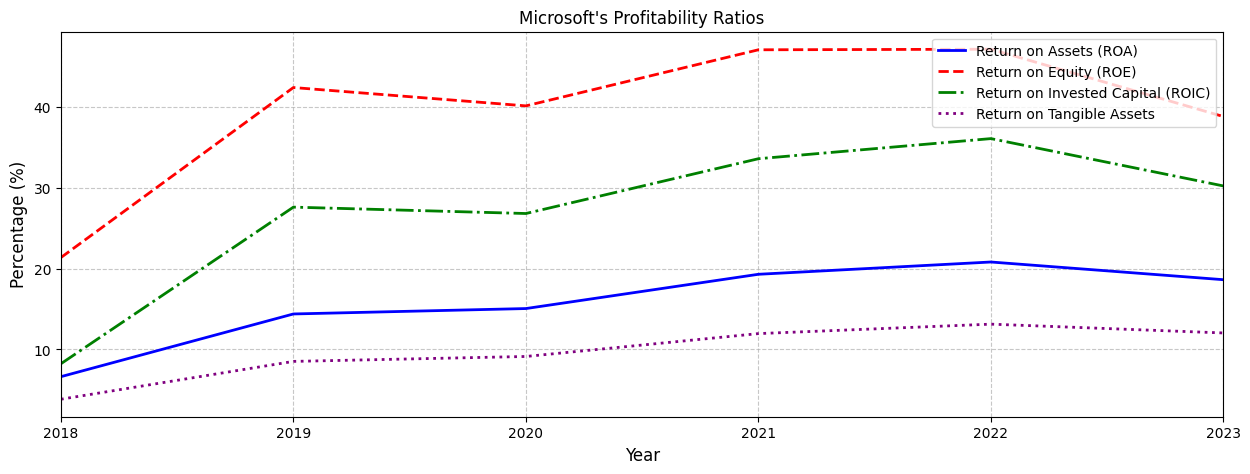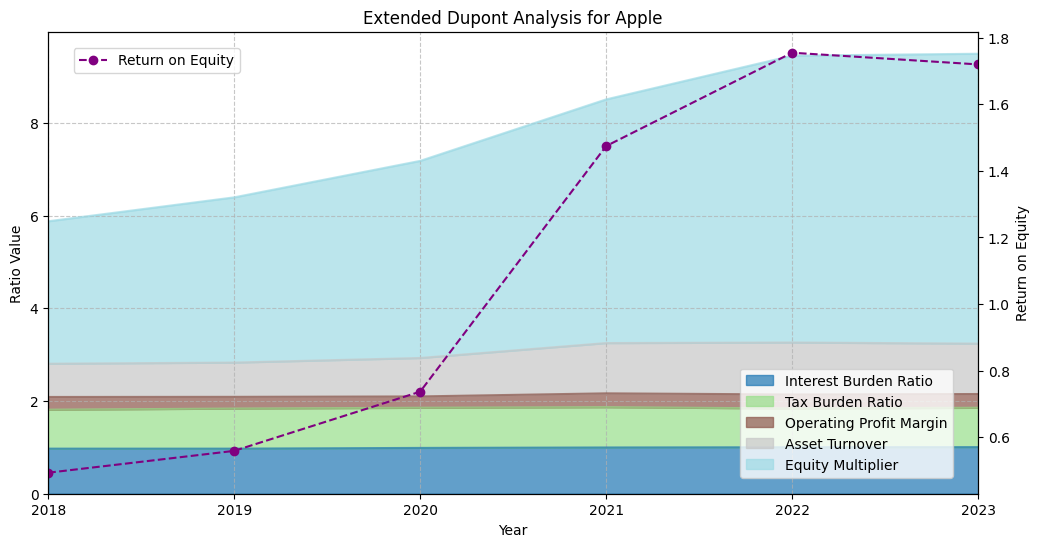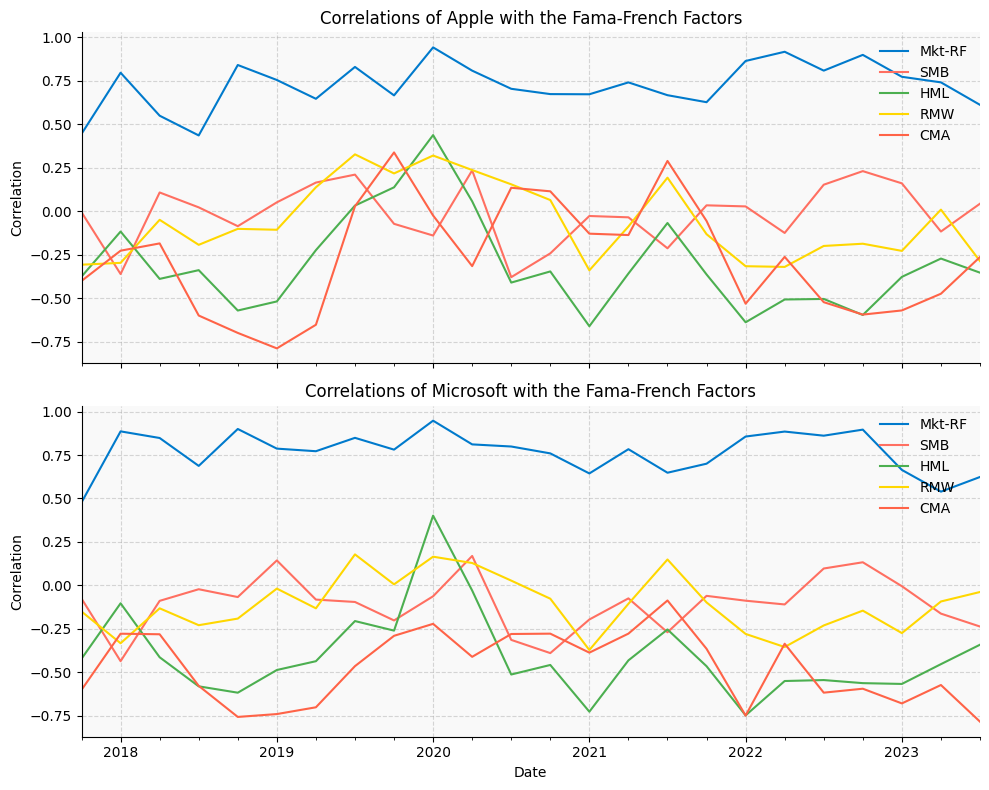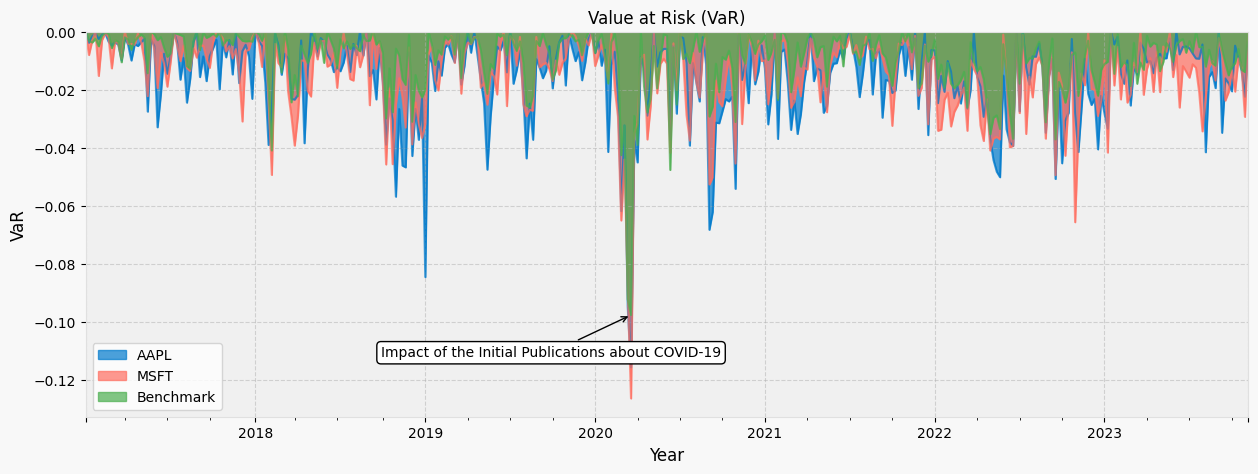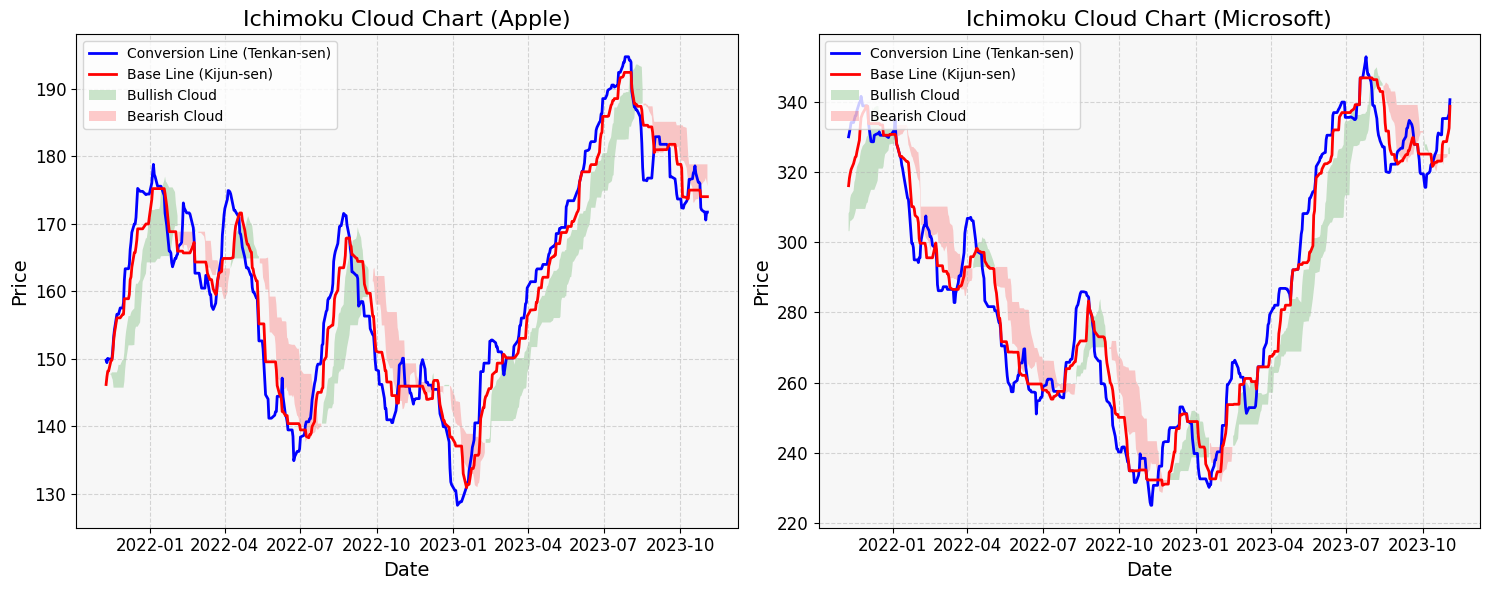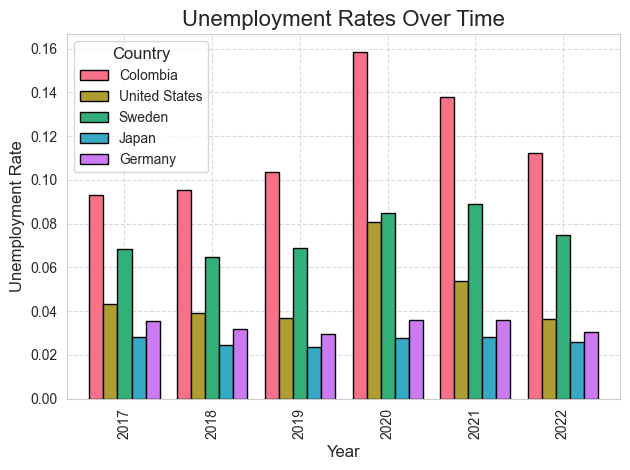Transparent and Efficient Financial Analysis
Project description
While browsing a variety of websites, I kept finding that the same financial metric can greatly vary per source and so do the financial statements reported while little information is given how the metric was calculated.
For example, Microsoft's Price-to-Earnings (PE) ratio on the 6th of May, 2023 is reported to be 28.93 (Stockopedia), 32.05 (Morningstar), 32.66 (Macrotrends), 33.09 (Finance Charts), 33.66 (Y Charts), 33.67 (Wall Street Journal), 33.80 (Yahoo Finance) and 34.4 (Companies Market Cap). All of these calculations are correct, however the method applied varies leading to different results. Therefore, collecting data from multiple sources can lead to wrong interpretation of the results given that one source could be applying a different calculation method than another. And that is, if it is even freely available. Often the calculation is hidden behind a paid subscription.
This is why I designed the FinanceToolkit, this is an open-source toolkit in which all relevant financial ratios (150+), indicators and performance measurements are written down in the most simplistic way allowing for complete transparency of the calculation method (proof). This allows you to not have to rely on metrics from other providers and, given a financial statement, allow for efficient manual calculations. This leads to one uniform method of calculation being applied that is available and understood by everyone.
The Finance Toolkit not only supports Equities. Even for Currencies, Cryptocurrencies, ETFs, Mutual Funds, Indices, Money Markets, Commodities, Key Economic Indicators and more, the Finance Toolkit can be used to obtain historical data as well as important performance and risk measurements such as the Sharpe Ratio and Value at Risk.
The Finance Toolkit is complimented very well with the Finance Database 🌎, a database that features 300.000+ symbols containing Equities, ETFs, Funds, Indices, Currencies, Cryptocurrencies and Money Markets. By utilising both, it is possible to do a fully-fledged competitive analysis with the tickers found from the FinanceDatabase inputted into the FinanceToolkit.

Table of Contents
Installation
Before installation, consider starring the project on GitHub which helps others find the project as well.
To install the FinanceToolkit it simply requires the following:
pip install financetoolkit -U
Then within Python use:
from financetoolkit import Toolkit
companies = Toolkit(
tickers=['GOOGL', 'MSFT', 'AMZN'],
api_key="FINANCIAL_MODELING_PREP_KEY",
)
To be able to get started, you need to obtain an API Key from FinancialModelingPrep. This is used to gain access to 30+ years of financial statement both annually and quarterly. Note that the Free plan is limited to 250 requests each day, 5 years of data and only features companies listed on US exchanges.
Through the link you are able to subscribe for the free plan and also premium plans at a 15% discount. This is an affiliate link and thus supports the project at the same time. I have chosen FinancialModelingPrep as a source as I find it to be the most transparent, reliable and at an affordable price. I have yet to find a platform offering such low prices for the amount of data offered. When you notice that the data is inaccurate or have any other issue related to the data, note that I simply provide the means to access this data and I am not responsible for the accuracy of the data itself. For this, use their contact form or provide the data yourself.
Functionality
The Finance Toolkit features the following functionality, also see Basic Usage to see some of these functions in action and the Code Documentation for a detailed explanation of each function.
| Feature | Description |
|---|---|
| Discover Instruments | Obtain lists of companies, cryptocurrencies, forex, commodities, etfs and indices including screeners, quotes, performance metrics and more to find and select tickers to use in the Finance Toolkit. For more information have a look here. |
| Company Overview | Obtain company profiles including a general description about the company as well as the current quote, the rating and recommendation based on a variety of different metrics such as the Discounted Cash Flow (DCF) and Return on Equity (RoE) |
| Historical Market Data | Obtain a full history of OHLC, dividends, (excess) returns, cumulative returns and (excess) volatility calculations on a daily, weekly, quarterly or yearly basis. This includes the normalization of the data as well as auto-adjustments for missing values. It can also be obtained from both FinancialModelingPrep and Yahoo Finance. |
| Treasury Rates | Just like the historical market data, obtain a full history for the treasury rates which also serve as risk-free rate by default allowing for calculations such as the Sharpe Ratio. This also includes normalization of the data as well as auto-adjustments for missing values. It can also be obtained from both FinancialModelingPrep and Yahoo Finance. |
| Dividends Calendar | Obtain the (adjusted) dividend and the the related record, payment and declaration dates. This represent both past and future dividend cashflows based on official statements from the selected companies. |
| Analyst Estimates | Obtain the expected Revenue, Earnings-per-Share (EPS), EBITDA, EBIT, Net Income, and SGA Expense from the past and future from a large collection of analysts. For each metric, it includes the lower bound, upper bound and median based on the analyst consensus. |
| Earnings Calendar | Retrieve precise dates for past and future earnings releases, including analyst expectations. These metrics are presented for both Earnings-per-Share (EPS) and Revenue. |
| Revenue Segmentation | Retrieve revenue segmentation based on both product design and geographic location for each company. Normalization is applied to ensure accurate comparisons of revenue streams over time among different companies. |
| ESG Scores | Retrieve comprehensive Environmental, Social, and Governance (ESG) scores for each company. The scores encompass various factors such as carbon footprint, diversity and inclusion efforts, ethical business practices, and board effectiveness. This information provides a holistic view of a company's sustainability and ethical practices in alignment with ESG criteria. |
| Financial Statements | Acquire a full history of both annual and quarterly financial statements, including balance sheets, income statements, and cash flow statements. These financial statements are normalized to facilitate straightforward comparisons between companies such as automatic currency conversions of the entire of the financial statement. Additionally, variations in accounting periods among companies are automatically standardized, ensuring that each company's year or quarter aligns with the corresponding calendar period. |
| Financial Ratios | Acquire 50+ financial ratios categorized into their key financial domains, including Efficiency, Liquidity, Profitability, Solvency, and Valuation. Efficiency ratios, such as Inventory Turnover and Asset Turnover provide insights into operational effectiveness. Liquidity ratios, including the Current and Quick Ratios, gauge the company's short-term financial viability. Profitability ratios, for example Return on Equity (RoE) and Net Profit Margin, shed light on the company's ability to generate profits. Solvency ratios, which include the Debt-to-Equity ratio or Interest Coverage ratio, assess the company's long-term financial stability. Valuation ratios, such as the Price-to-Earnings (P/E) ratio and Earnings Yield, offer perspectives on the company's market valuation. Find all of them here. |
| Custom Ratios | Define custom ratios and calculate these automatically based on the balance sheet, income and cash flow statements. With this, it is possible to calculate any collection of custom ratios without needing to understanding the backend of the Finance Toolkit. Learn how here. |
| Financial Models | Access a variety of financial models that combine the historical market data and financial statements. This is for example the DUPONT analysis, Weighted Average Cost of Capital (WACC), and Altman Z-Score. Find all of them here. |
| Performance Metrics | Access a variety of performance metrics, including Jensens Alpha, Capital Asset Pricing Model (CAPM), and (Rolling) Sharpe Ratio. These metrics provide a comprehensive evaluation of a company's financial performance, risk-adjusted returns, and its relationship with market benchmarks. Find all of them here. |
| Risk Metrics | Access a diverse set of risk metrics, including the Value at Risk (VaR), GARCH, and Entropic Value at Risk (eVaR). These metrics are meant to gauge the potential major losses that can occur over time as well as estimate future volatilities. Find all of them here. |
| Technical Indicators | Access an extensive array of more than 40 technical indicators such as the Relative Strength Index (RSI), Exponential Moving Average (EMA), and Bollinger Bands. These technical indicators are key to understanding short-term market trends, momentum, and volatility. Find all of them here. |
| Key Economic Indicators | Access an extensive collection of over 50 macro-economic indicators such as Gross Domestic Product (GDP), Consumer Price Index (CPI), and Federal Funds Rate (FED). These indicators serve as barometers to understand the economic, environmental and social climate of 60+ countries. Find all of them here. |
The dependencies of the package are on purpose very slim so that it will work well with any combination of packages and not result in conflicts.
Basic Usage
This section is an introduction to the Finance Toolkit. Also see this notebook for a detailed Getting Started guide as well as this notebook that includes the Finance Database 🌎 and a proper financial analysis. Next to that, find below a fully-fledged code documentation as well as Jupyter Notebooks in which you can see many examples ranging from basic examples to creating custom ratios to working with your own datasets.
A basic example of how to use the Finance Toolkit is shown below.
from financetoolkit import Toolkit
companies = Toolkit(["AAPL", "MSFT"], api_key=API_KEY, start_date="2017-12-31")
# a Historical example
historical_data = companies.get_historical_data()
# a Financial Statement example
income_statement = companies.get_income_statement()
# a Ratios example
profitability_ratios = companies.ratios.collect_profitability_ratios()
# a Models example
extended_dupont_analysis = companies.models.get_extended_dupont_analysis()
# a Performance example
factor_asset_correlations = companies.performance.get_factor_asset_correlations(period='quarterly')
# a Risk example
value_at_risk = companies.risk.get_value_at_risk(period="weekly")
# a Technical example
ichimoku_cloud = companies.technicals.get_ichimoku_cloud()
# an Economics example
unemployment_rates = companies.economics.get_unemployment_rate()
Generally, the functions return a DataFrame with a multi-index in which all tickers, in this case Apple and Microsoft, are presented. To keep things manageable for this README, I select just Apple but in essence the list of tickers can be endless as I've seen DataFrames with thousands of tickers. The filtering is done through .loc['AAPL'] and .xs('AAPL', level=1, axis=1) based on whether it's fundamental data or historical data respectively.
Obtaining Historical Data
Obtain historical data on a daily, weekly, monthly or yearly basis. This includes OHLC, volumes, dividends, returns, cumulative returns and volatility calculations for each corresponding period. For example, the a portion of the historical data for Apple is shown below.
| date | Open | High | Low | Close | Adj Close | Volume | Dividends | Return | Volatility | Excess Return | Excess Volatility | Cumulative Return |
|---|---|---|---|---|---|---|---|---|---|---|---|---|
| 2018-01-02 | 42.54 | 43.075 | 42.315 | 43.065 | 40.78 | 1.02224e+08 | 0 | 0 | 0.0202 | -0.0067 | 0.0233 | 1 |
| 2018-01-03 | 43.1325 | 43.6375 | 42.99 | 43.0575 | 40.77 | 1.17982e+08 | 0 | -0.0002 | 0.0202 | -0.0247 | 0.0233 | 0.9998 |
| 2018-01-04 | 43.135 | 43.3675 | 43.02 | 43.2575 | 40.96 | 8.97384e+07 | 0 | 0.0047 | 0.0202 | -0.0198 | 0.0233 | 1.0044 |
| 2018-01-05 | 43.36 | 43.8425 | 43.2625 | 43.75 | 41.43 | 9.46401e+07 | 0 | 0.0115 | 0.0202 | -0.0133 | 0.0233 | 1.0159 |
| 2018-01-08 | 43.5875 | 43.9025 | 43.4825 | 43.5875 | 41.27 | 8.22711e+07 | 0 | -0.0039 | 0.0202 | -0.0287 | 0.0233 | 1.012 |
And below the cumulative returns are plotted which include the S&P 500 as benchmark:
Obtaining Financial Statements
Obtain an Income Statement on an annual or quarterly basis. This can also be an income statement (companies.get_income_statement()) or cash flow statement (companies.get_cash_flow_statement()). For example, the first 5 rows of the Income Statement for Apple are shown below.
| 2017 | 2018 | 2019 | 2020 | 2021 | 2022 | 2023 | |
|---|---|---|---|---|---|---|---|
| Revenue | 2.29234e+11 | 2.65595e+11 | 2.60174e+11 | 2.74515e+11 | 3.65817e+11 | 3.94328e+11 | 3.83285e+11 |
| Cost of Goods Sold | 1.41048e+11 | 1.63756e+11 | 1.61782e+11 | 1.69559e+11 | 2.12981e+11 | 2.23546e+11 | 2.14137e+11 |
| Gross Profit | 8.8186e+10 | 1.01839e+11 | 9.8392e+10 | 1.04956e+11 | 1.52836e+11 | 1.70782e+11 | 1.69148e+11 |
| Gross Profit Ratio | 0.3847 | 0.3834 | 0.3782 | 0.3823 | 0.4178 | 0.4331 | 0.4413 |
| Research and Development Expenses | 1.1581e+10 | 1.4236e+10 | 1.6217e+10 | 1.8752e+10 | 2.1914e+10 | 2.6251e+10 | 2.9915e+10 |
And below the Earnings Before Interest, Taxes, Depreciation and Amortization (EBITDA) are plotted for both Apple and Microsoft.
Obtaining Financial Ratios
Get Profitability Ratios based on the inputted balance sheet, income and cash flow statements. This can be any of the 50+ ratios within the ratios module. The get_ functions show a single ratio whereas the collect_ functions show an aggregation of multiple ratios. For example, see some of the profitability ratios of Microsoft below.
| 2017 | 2018 | 2019 | 2020 | 2021 | 2022 | 2023 | |
|---|---|---|---|---|---|---|---|
| Gross Margin | 0.6191 | 0.6525 | 0.659 | 0.6778 | 0.6893 | 0.684 | 0.6892 |
| Operating Margin | 0.2482 | 0.3177 | 0.3414 | 0.3703 | 0.4159 | 0.4206 | 0.4177 |
| Net Profit Margin | 0.2357 | 0.1502 | 0.3118 | 0.3096 | 0.3645 | 0.3669 | 0.3415 |
| Interest Coverage Ratio | 13.9982 | 16.5821 | 20.3429 | 25.3782 | 34.7835 | 47.4275 | 52.0244 |
| Income Before Tax Profit Margin | 0.2574 | 0.3305 | 0.3472 | 0.3708 | 0.423 | 0.4222 | 0.4214 |
And below a few of the profitability ratios are plotted for Microsoft.
Obtaining Financial Models
Get an Extended DuPont Analysis based on the inputted balance sheet, income and cash flow statements. This can also be an Enterprise Value Breakdown, Weighted Average Cost of Capital (WACC), Altman Z-Score and many more models. For example, this shows the Extended DuPont Analysis for Apple:
| 2017 | 2018 | 2019 | 2020 | 2021 | 2022 | 2023 | |
|---|---|---|---|---|---|---|---|
| Interest Burden Ratio | 0.9572 | 0.9725 | 0.9725 | 0.988 | 0.9976 | 1.0028 | 1.005 |
| Tax Burden Ratio | 0.7882 | 0.8397 | 0.8643 | 0.8661 | 0.869 | 0.8356 | 0.8486 |
| Operating Profit Margin | 0.2796 | 0.2745 | 0.2527 | 0.2444 | 0.2985 | 0.302 | 0.2967 |
| Asset Turnover | nan | 0.7168 | 0.7389 | 0.8288 | 1.0841 | 1.1206 | 1.0868 |
| Equity Multiplier | nan | 3.0724 | 3.5633 | 4.2509 | 5.255 | 6.1862 | 6.252 |
| Return on Equity | nan | 0.4936 | 0.5592 | 0.7369 | 1.4744 | 1.7546 | 1.7195 |
And below each component of the Extended Dupont Analysis is plotted including the resulting Return on Equity (ROE).
Obtaining Performance Metrics
Get the correlations with the factors as defined by Fama-and-French. These include market, size, value, operating profitability and investment. The beauty of all functionality here is that it can be based on any period as the function accepts the period 'weekly', 'monthly', 'quarterly' and 'yearly'. For example, this shows the quarterly correlations for Apple:
| Mkt-RF | SMB | HML | RMW | CMA | |
|---|---|---|---|---|---|
| 2022Q2 | 0.9177 | -0.1248 | -0.5077 | -0.3202 | -0.2624 |
| 2022Q3 | 0.8092 | 0.1528 | -0.5046 | -0.1997 | -0.5231 |
| 2022Q4 | 0.8998 | 0.2309 | -0.5968 | -0.1868 | -0.5946 |
| 2023Q1 | 0.7737 | 0.1606 | -0.3775 | -0.228 | -0.5707 |
| 2023Q2 | 0.7416 | -0.1166 | -0.2722 | 0.0093 | -0.4745 |
And below the correlations with each factor are plotted over time for both Apple and Microsoft.
Obtaining Risk Metrics
Get the Value at Risk for each week. Here, the days within each week are considered for the Value at Risk. This makes it so that you can understand within each period what is the expected Value at Risk (VaR) which can again be any period but also based on distributions such as Historical, Gaussian, Student-t, Cornish-Fisher.
| AAPL | MSFT | Benchmark | |
|---|---|---|---|
| 2023-09-25/2023-10-01 | -0.0205 | -0.0133 | -0.0122 |
| 2023-10-02/2023-10-08 | -0.0048 | -0.0206 | -0.0108 |
| 2023-10-09/2023-10-15 | -0.0089 | -0.0092 | -0.0059 |
| 2023-10-16/2023-10-22 | -0.0135 | -0.0124 | -0.0131 |
| 2023-10-23/2023-10-29 | -0.0224 | -0.0293 | -0.0139 |
And below the Value at Risk (VaR) for Apple, Microsoft and the benchmark (S&P 500) are plotted also demonstrating the impact of COVID-19.
Obtaining Technical Indicators
Get the Ichimoku Cloud parameters based on the historical market data. This can be any of the 30+ technical indicators within the technicals module. The get_ functions show a single indicator whereas the collect_ functions show an aggregation of multiple indicators. For example, see some of the parameters for Apple below:
| Date | Base Line | Conversion Line | Leading Span A | Leading Span B |
|---|---|---|---|---|
| 2023-10-30 | 174.005 | 171.755 | 176.245 | 178.8 |
| 2023-10-31 | 174.005 | 171.755 | 176.37 | 178.8 |
| 2023-11-01 | 174.005 | 170.545 | 176.775 | 178.8 |
| 2023-11-02 | 174.005 | 171.725 | 176.235 | 178.8 |
| 2023-11-03 | 174.005 | 171.725 | 175.558 | 178.8 |
And below the Ichimoku Cloud parameters are plotted for Apple and Microsoft side-by-side.
Understanding Key Economic Indicators
Get insights for 60+ countries into key economic indicators such as the Consumer Price Index (CPI), Gross Domestic Product (GDP), Unemployment Rates and 3-month and 10-year Government Interest Rates. This is done through the economics module and can be used as a standalone module as well by using from financetoolkit import Economics. For example see a selection of the countries below:
| Colombia | United States | Sweden | Japan | Germany | |
|---|---|---|---|---|---|
| 2017 | 0.093 | 0.0435 | 0.0686 | 0.0281 | 0.0357 |
| 2018 | 0.0953 | 0.039 | 0.0648 | 0.0244 | 0.0321 |
| 2019 | 0.1037 | 0.0367 | 0.0691 | 0.0235 | 0.0298 |
| 2020 | 0.1586 | 0.0809 | 0.0848 | 0.0278 | 0.0362 |
| 2021 | 0.1381 | 0.0537 | 0.0889 | 0.0282 | 0.0358 |
| 2022 | 0.1122 | 0.0365 | 0.0748 | 0.026 | 0.0307 |
And below these Unemployment Rates are plotted over time:
Available Metrics
The Finance Toolkit has the ability to calculate 150+ financial metrics. The following list shows all of the available metrics. Note that the Finance Toolkit is not limited to these ratios and indicators as it is possible to add custom ratios as well. See this Notebook for more information.
Each ratio and indicator has a corresponding function that can be called directly for example ratios.get_return_on_equity or technicals.get_relative_strength_index.
Financial Ratios
The Ratios Module contains over 50+ ratios that can be used to analyse companies. These ratios are divided into 5 categories which are efficiency, liquidity, profitability, solvency and valuation. Each ratio is calculated using the data from the Toolkit module. Find the documentation here which includes an explanation about the ratio, the parameters and an example.
All of these ratios can be calculated based on (lagged) growth as well as trailing (e.g. TTM) metrics. This is embedded in all ratios as well as the financial statements themselves which means it is possible to calculate revenue growth and 12-month (TTM) Price-to-Earnings with the parameters growth=True and trailing=4 respectively. Note that trailing is based on periods therefore TTM can only be calculated by setting quarterly=True in the Toolkit initialization.
Efficiency Ratios ⚙️
- Asset Turnover Ratio
- Inventory Turnover Ratio
- Days of Inventory Outstanding
- Days of Sales Outstanding
- Operating Cycle
- Accounts Payables Turnover Ratio
- Days of Accounts Payable Outstanding
- Cash Conversion Cycle (CCC)
- Cash Conversion Efficiency (CCE)
- Receivables Turnover
- SGA to Revenue Ratio
- Fixed Asset Turnover
- Operating Ratio
Liquidity Ratios 💧
- Current Ratio
- Quick Ratio
- Cash Ratio
- Working Capital
- Operating Cash Flow Ratio
- Operating Cash Flow Sales Ratio
- Short Term Coverage Ratio
Profitability Ratios 💰
- Gross Margin
- Operating Margin
- Net Profit Margin
- Interest Burden Ratio
- Income Before Tax Profit Margin
- Effective Tax Rate
- Return on Assets (RoA)
- Return on Equity (RoE)
- Return on Invested Capital (RoIC)
- Income Quality Ratio
- Return on Tangible Assets (RoTA)
- Return on Capital Employed (RoCE)
- Net Income per EBT
- Free Cash Flow Operating Cash Flow Ratio
- Tax Burden Ratio
- EBT to EBIT
- EBIT to Revenue
Solvency Ratios 🪨
- Debt to Assets Ratio
- Debt to Equity Ratio
- Interest Coverage Ratio
- Equity Multiplier
- Debt Service Coverage Ratio
- Free Cash Flow Yield
- Net Debt to EBITDA Ratio
- Cash Flow Coverage Ratio
- CAPEX Coverage Ratio
- CAPEX Dividend Coverage Ratio
Valuation Ratios ⚖️
- Earnings per Share (EPS)
- Revenue per Share (RPS)
- Price Earnings Ratio (PE)
- Price to Earnings Growth Ratio (PEG)
- Book Value per Share
- Price to Book Ratio (PB)
- Interest Debt per Share
- CAPEX per Share
- Dividend Yield
- Weighted Dividend Yield
- Price to Cash Flow Ratio (P/CF)
- Price to Free Cash Flow Ratio (P/FCF)
- Market Capitalization
- Enterprise Value
- EV to Sales Ratio
- EV to EBITDA Ratio
- EV to Operating Cashflow Ratio
- EV to EBIT
- Earnings Yield
- Dividend Payout Ratio
- Reinvestment Rate
- Tangible Asset Value
- Net Current Asset Value
Financial Models
The Models module is meant to execute well-known models such as DUPONT and the Discounted Cash Flow (DCF) model. These models are also directly related to the data retrieved from the Toolkit module. Find the documentation here which includes an explanation about the model, the parameters and an example.
- DuPont Analysis
- Extended DuPont Analysis
- Enterprise Value Breakdown
- Weighted Average Cost of Capital (WACC)
- Intrinsic Valuation
- Altman Z-Score
- Piotroski F-Score
- Present Value of Growth Opportunities (PVGO)
Performance Metrics
The Performance module is meant to calculate important performance metrics such as Sharpe Ratio, Sortino Ratio, Treynor Ratio, Information Ratio, Jensen's Alpha, Beta, Capital Asset Pricing Model, Factor Models and more. Find the documentation here which includes an explanation about the performance metrics, the parameters and an example.
- Alpha
- Jensen's Alpha
- Beta
- Capital Asset Pricing Model (CAPM)
- Factor Asset Correlations
- Factor Correlations
- Fama-French 5 Factor Model (FF)
- Treynor Ratio
- Sharpe Ratio
- Sortino Ratio
- Ulcer Performance Index (UPI)
- M2 Ratio
- Tracking Error
- Information Error
- Compound Annual Growth Rate (CAGR)
Risk Metrics
The Risk module is meant to calculate important risk metrics such as Value at Risk (VaR), Conditional Value at Risk (cVaR), Maximum Drawdown, Correlations, Beta, GARCH, EWMA and more. Find the documentation here which includes an explanation about the risk metrics, the parameters and an example.
- Black Scholes Model
- Value at Risk (VaR) with distributions Historical, Gaussian, Student-t, Cornish-Fisher.
- Conditional Value at Risk (cVaR) with distributions Historical, Gaussian, Laplace, Logistic.
- Entropic Value at Risk (eVaR) with a Gaussian distribution.
- GARCH (Generalized Autoregressive Conditional Heteroskedasticity) with Forecasting
- Ulcer Index (UI)
- Maximum Drawdown (MDD)
- Skewness
- Kurtosis
Technical Indicators
The Technicals Module contains 30+ Technical Indicators that can be used to analyse companies. These ratios are divided into 4 categories which are breadth, momentum, overlap and volatility. Each indicator is calculated using the data from the Toolkit module. Find the documentation here which includes an explanation about the indicator, the parameters and an example.
Breadth Indicators 💨
- McClellan Oscillator
- Advancers/Decliners Ratio
- On-Balance Volume (OBV)
- Accumulation/Distribution Line (ADL)
- Chaikin Oscillator
Momentum Indicators ⏱️
- Money Flow Index
- Williams %R
- Aroon Indicator
- Commodity Channel Index
- Relative Vigor Index
- Force Index
- Ultimate Oscillator
- Percentage Price Oscillator
- Detrended Price Oscillator
- Average Directional Index (ADX)
- Chande Momentum Oscillator (CMO)
- Ichimoku Cloud
- Stochastic Oscillator
- Moving Average Convergence Divergence (MACD)
- Relative Strength Index (RSI)
- Balance of Power (BOP)
Overlap Indicators 🌈
- Simple Moving Average (SMA)
- Exponential Moving Average (EMA)
- Double Exponential Moving Average (DEMA)
- Triple Exponential Moving Average (TRIX)
- Triangular Moving Average (TMA)
Volatility Indicators ⚠️
- True Range (TR)
- Average True Range (ATR)
- Keltners Channels
- Bollinger Bands
Key Economic Indicators
The Economics Module contains a variety of Key Economic Indicators that help in understanding the health and performance of more than 60 different countries. This module can be called directly via the Toolkit but also separately if desired through from financetoolkit import Economics. Find the documentation here which includes an explanation about each indicator, the parameters and an example.
Economy 💵
- Gross Domestic Product (GDP) including Growth and Forecasts
- Consumer Confidence Index (CCI)
- Business Confidence Index (BCI)
- Composite Leading Indicator (CLI)
- Consumer Price Index (CPI)
- Producer Price Index (PPI)
- House and Rent Prices
- Share Prices
Finance 💹
- Long Term Interest Rates (10 year)
- Short Term Interest Rates (3 month)
- Narrow Money (M1)
- Broad Money (M3)
- Purchasing Power Parity (PPP)
- Exchange Rates
Central Banks 🏦
- Main Refinancing Operations (ECB)
- Marginal Lending Facility (ECB)
- Deposit Facility (ECB)
- Effective Federal Funds Rate (FED)
- Overnight Bank Funding Rate (FED)
- Tri-Party General Collateral Rate (FED)
- Broad General Collateral Rate (FED)
- Secured Overnight Financing Rate (FED)
Environment 💚
- Renewable Energy as % of Total Energy
- Environmental Tax as % of GDP
- Greenhouse Gas Emissions
- Crude Oil Production and Prices
Government 🏛️
- Deficit as % of GDP
- Revenue as % of GDP
- Spending as % of GDP
- Debt as % of GDP
- Financial Wealth as % of GDP
- Production Costs as % of GDP
- Central Spending based on the System of National accounts (SNA)
- Trust in Government
Jobs 🗂️
- Unemployment Rates
- Labour Productivity
- Income Inequality
Society 👪
- Population
- Young Population
- Working Age Population
- Elderly Population
- Fertility Rates
- Old-Age Dependency Ratio
- Poverty Rate
Questions & Answers
This section includes frequently asked questions and is meant to clear up confusion about certain results and/or deviations from other sources. If you have any questions that are not answered here, feel free to reach out to me via the contact details below.
How do you deal with companies that have different fiscal years?
For any financial statement, I make sure to line it up with the corresponding calendar period. For example, Apple's Q4 2023 relates to July to September of 2023. This corresponds to the calendar period Q3 which is why I normalize Apple's numbers to Q3 2023 instead. This is done to allow for comparison between companies that have different fiscal years.
Why do the numbers in the financial statements sometimes deviate from the data from FinancialModelingPrep?
When looking at a company such as Hyundai Motor Company (ticker: 005380.KS), you will notice that the financial statements are reported in KRW (South Korean won). As this specific ticker is listed on the Korean Exchange, the historical market data will also be reported in KRW. However, if you use the ticker HYMTF, which is listed on the American OTC market, the historical market data will be reported in USD. To deal with this discrepancy, the end of year or end of quarter exchange rate is retrieved which is used to convert the financial statements to USD. This is done to prevent ratio calculations such as the Free Cash Flow Yield (which is based on the market capitalization) or Price Earnings Ratio (which is based on the stock price) from being incorrect. This can be disabled by setting convert_currency=False in the Toolkit initialization. It is recommended to always use the ticker that is listed on the exchange where the company is based.
How can I get TTM (Trailing Twelve Months) and Growth metrics?
Most functions will have the option to define the trailing parameter. This lets you define the number of periods that you want to use to calculate the trailing metrics. For example, if you want to calculate the trailing 12-month (TTM) Price-to-Earnings Ratio, you can set trailing=4 when you have set quarterly=True in the Toolkit initialization. The same goes for growth metrics which can be calculated by setting growth=True. This will calculate the growth for each period based on the previous period. This also includes a lag parameter in which you can define lagged growth. Furthermore, you can also combine the trailing and growth parameters to get trailing growth. For example, set trailing=4 and growth=True for the Price-to-Earnings Ratio which will then calculate the TTM growth.
How can I save the data periodically so that I don't have to retrieve it every single time again?
The Toolkit initialization has the ability to add custom datasets which can serve as input for external datasets from different providers but also to prevent downloading all of the same data again. Have a look at this comment that explains this further.
What is the "Benchmark" that is automatically obtained when acquiring historical data?
This is related to the benchmark_ticker parameter which is set to "SPY" (S&P 500) by default. This is important when calculating performance metrics such as the Sharpe Ratio or Treynor Ratio that require a market return. This can be disabled by setting benchmark_ticker=None in the Toolkit initialization.
Are you part of FinancialModelingPrep?
No, I am not. I've merely picked them as the primary data provider given that they have a generous free tier and fair pricing compared to other providers. Therefore, any questions related to the data should go through their contact form. When it comes to any type of ratios, performance metrics, risk metrics, technical indicators or economic indicators, feel free to reach out to me as this is my own work.
Contributing
First off all, thank you for taking the time to contribute (or at least read the Contributing Guidelines)! 🚀
The goal of the Finance Toolkit is to make any type of financial calculation as transparent and efficient as possible. I want to make these type of calculations as accessible to anyone as possible and seeing how many websites exists that do the same thing (but instead you have to pay) gave me plenty of reasons to work on this.
Contact
If you have any questions about the FinanceToolkit or would like to share with me what you have been working on, feel free to reach out to me via:
- Website: https://jeroenbouma.com/
- Twitter: https://twitter.com/JerBouma
- LinkedIn: https://www.linkedin.com/in/boumajeroen/
- Email: jer.bouma@gmail.com
- Discord: add me on Discord
JerBouma
If you'd like to support my efforts, either help me out by contributing to the package or Sponsor Me.
Project details
Release history Release notifications | RSS feed
Download files
Download the file for your platform. If you're not sure which to choose, learn more about installing packages.
Source Distribution
Built Distribution
File details
Details for the file financetoolkit-1.7.4.tar.gz.
File metadata
- Download URL: financetoolkit-1.7.4.tar.gz
- Upload date:
- Size: 212.6 kB
- Tags: Source
- Uploaded using Trusted Publishing? No
- Uploaded via: twine/4.0.2 CPython/3.10.9
File hashes
| Algorithm | Hash digest | |
|---|---|---|
| SHA256 | 1d5b25cded110af663e26b2dff70384ca829758b70c89ae10be5b226921cda79 |
|
| MD5 | e892076222f87cba2583a9dd4fae744f |
|
| BLAKE2b-256 | a134e4865608e6374fe94293cfb8643c86f5d0cd416bf6bce600cc73ab37b8e3 |
File details
Details for the file financetoolkit-1.7.4-py3-none-any.whl.
File metadata
- Download URL: financetoolkit-1.7.4-py3-none-any.whl
- Upload date:
- Size: 223.4 kB
- Tags: Python 3
- Uploaded using Trusted Publishing? No
- Uploaded via: twine/4.0.2 CPython/3.10.9
File hashes
| Algorithm | Hash digest | |
|---|---|---|
| SHA256 | 9335666867373a41db957681cd9c96eb9ed898a9829a508e5c32cc8a5ce1fb35 |
|
| MD5 | 346d8827d1df3221ce4e1657e537a462 |
|
| BLAKE2b-256 | c51faa66dc4be2431aab456392ccf20d0cc68d104abc877bc3e322fb28d70bca |













